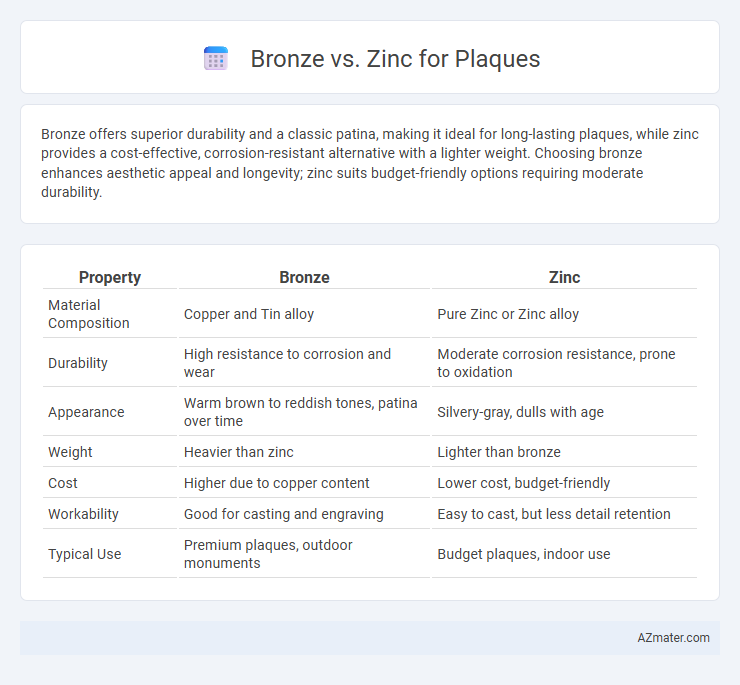Bronze offers superior durability and a classic patina, making it ideal for long-lasting plaques, while zinc provides a cost-effective, corrosion-resistant alternative with a lighter weight. Choosing bronze enhances aesthetic appeal and longevity; zinc suits budget-friendly options requiring moderate durability.
Table of Comparison
| Property | Bronze | Zinc |
|---|---|---|
| Material Composition | Copper and Tin alloy | Pure Zinc or Zinc alloy |
| Durability | High resistance to corrosion and wear | Moderate corrosion resistance, prone to oxidation |
| Appearance | Warm brown to reddish tones, patina over time | Silvery-gray, dulls with age |
| Weight | Heavier than zinc | Lighter than bronze |
| Cost | Higher due to copper content | Lower cost, budget-friendly |
| Workability | Good for casting and engraving | Easy to cast, but less detail retention |
| Typical Use | Premium plaques, outdoor monuments | Budget plaques, indoor use |
Introduction to Plaque Materials
Bronze and zinc are two common materials used for plaques, each offering distinct durability and aesthetic qualities. Bronze, an alloy primarily of copper and tin, provides a classic, corrosion-resistant finish ideal for outdoor memorials and signage, while zinc, a more affordable metal, offers ease of casting and a weather-resistant surface suitable for indoor and some outdoor plaques. Selecting the right material depends on factors like budget, environmental exposure, and desired longevity.
Overview of Bronze and Zinc
Bronze, an alloy primarily composed of copper and tin, is prized for its durability, corrosion resistance, and warm, classic patina, making it ideal for long-lasting plaques and outdoor monuments. Zinc, a corrosion-resistant metal known for its affordability and malleability, offers a lightweight alternative with a subtle gray finish that ages well without significant degradation. Both metals provide excellent casting properties, but bronze is often preferred for its premium appearance and heritage association in commemorative plaques.
Historical Use of Bronze in Plaques
Bronze has been historically favored for plaques due to its durability, corrosion resistance, and aesthetic appeal, making it ideal for outdoor memorials and commemorative markers since ancient times. Its copper and tin composition allows for detailed engraving and develops a distinguished patina over time, enhancing the plaque's visual character. Zinc, while more cost-effective and resistant to rust, lacks the long-standing cultural and artistic significance that bronze plaques have maintained throughout history.
Benefits of Choosing Bronze Plaques
Bronze plaques offer superior durability and resistance to corrosion compared to zinc, making them ideal for outdoor memorials and signage. The metal's natural patina develops over time, enhancing the plaque's aesthetic appeal and preserving inscriptions clearly. Bronze also provides a more prestigious, elegant finish that adds lasting value to any commemorative display.
The Appeal of Zinc Plaques
Zinc plaques offer a modern aesthetic and superior resistance to corrosion compared to traditional bronze, making them ideal for outdoor commemorations and signage. Their affordability and ease of customization allow for detailed engravings and vibrant finishes that maintain clarity over time. Zinc's lightweight nature and durability enhance installation flexibility, attracting institutions and individuals seeking cost-effective yet elegant plaque solutions.
Durability: Bronze vs Zinc
Bronze plaques exhibit superior durability due to their resistance to corrosion and weathering, maintaining structural integrity and appearance over decades even in harsh outdoor conditions. Zinc plaques, while cost-effective and offering moderate corrosion resistance, tend to develop a patina and may degrade faster when exposed to extreme moisture or pollutants. The inherent hardness and density of bronze make it the preferred choice for long-lasting commemorative plaques requiring sustained aesthetic appeal and robustness.
Cost Comparison: Bronze vs Zinc
Bronze plaques typically cost more than zinc plaques due to the higher price of copper and tin alloy materials combined with more labor-intensive casting processes. Zinc plaques offer a budget-friendly alternative, often priced 30-50% lower, making them ideal for large quantities or short-term use. Despite cost differences, bronze provides superior durability and a classic aesthetic value that can justify the higher investment for long-lasting memorials or commemorative purposes.
Aesthetic Differences
Bronze plaques exhibit a rich, warm patina that deepens over time, offering a classic and timeless aesthetic ideal for commemorative markers. Zinc plaques present a cooler, bluish-gray tone with a smooth, matte finish, providing a modern and understated look suitable for contemporary settings. The choice between bronze and zinc significantly influences the plaque's visual impact, with bronze emphasizing tradition and durability, while zinc offers subtle elegance and resistance to surface corrosion.
Maintenance and Longevity
Bronze plaques exhibit superior longevity and develop a natural patina over time, enhancing their aesthetic while requiring minimal maintenance compared to zinc. Zinc plaques resist corrosion and maintain their appearance well but may need periodic cleaning to prevent surface buildup. Choosing bronze ensures a durable, low-maintenance option ideal for historical or outdoor commemorations with lasting visual appeal.
Which Material is Best for Your Plaque?
Bronze offers exceptional durability and a classic, prestigious appearance, making it ideal for long-lasting plaques displayed outdoors or in formal settings. Zinc is more cost-effective, resistant to corrosion, and provides a modern, matte finish suitable for budget-conscious projects or indoor use. Choosing between bronze and zinc hinges on the plaque's intended environment, budget constraints, and desired aesthetic impact.

Infographic: Bronze vs Zinc for Plaque
 azmater.com
azmater.com